
This is a table of selected pistol/submachine gun and rifle/machine gun cartridges by common name. Data values are the highest found for the cartridge, and might not occur in the same load.

The .40 S&W is a rimless pistol cartridge developed jointly by American firearms manufacturers Smith & Wesson and Winchester in 1990. The .40 S&W was developed as a law enforcement cartridge designed to duplicate performance of the Federal Bureau of Investigation's (FBI) reduced-velocity 10mm Auto cartridge which could be retrofitted into medium-frame semi-automatic handguns. It uses 0.40-inch (10 mm) diameter bullets ranging in weight from 105 to 200 grains.

The .45 ACP, also known as .45 Auto, .45 Automatic, or 11.43×23mm is a rimless straight-walled handgun cartridge designed by John Moses Browning in 1904, for use in his prototype Colt semi-automatic pistol. After successful military trials, it was adopted as the standard chambering for Colt's M1911 pistol. The round was developed due to a lack of stopping power experienced in the Moro Rebellion in places like Sulu. The issued ammunition, .38 Long Colt, had proved inadequate, motivating the search for a better cartridge. This experience and the Thompson–LaGarde Tests of 1904 led the Army and the Cavalry to decide that a minimum of .45 caliber was required in a new handgun cartridge.

The .380 ACP (9×17mm) is a rimless, straight-walled pistol cartridge developed by firearms designer John Moses Browning. The cartridge headspaces on the mouth of the case. It was introduced in 1908 by Colt, for use in its new Colt Model 1908 pocket hammerless semi-automatic, and has been a popular self-defense cartridge ever since, seeing wide use in numerous handguns. Other names for .380 ACP include .380 Auto, 9×17mm, 9mm Browning, 9mm Corto, 9mm Kurz, 9mm Short, and 9mm Browning Court. It should not be confused with .38 ACP. The .380 ACP does not strictly conform to cartridge naming conventions, named after the diameter of the bullet, as the actual bullet diameter of the .380 ACP is .355 inches.

The .357 Smith & Wesson Magnum, .357 S&W Magnum, .357 Magnum, or 9×33mmR is a smokeless powder cartridge with a 0.357 in (9.07 mm) bullet diameter. It was created by Elmer Keith, Phillip B. Sharpe, and Douglas B. Wesson of firearm manufacturers Smith & Wesson and Winchester. The .357 Magnum cartridge is notable for its highly effective terminal ballistics.
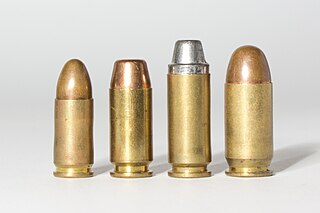
The 9×19mm Parabellum is a rimless, tapered firearms cartridge.

The .38 Super, also known as .38 Super +P, .38 Super Auto, .38 Super Automatic, .38 Super Automatic +P, or 9×23mmSR, is a pistol cartridge that fires a 0.356-inch-diameter (9.04 mm) bullet. It was introduced in the late 1920s as a higher pressure loading of the .38 ACP, also known as .38 Auto. The older .38 ACP cartridge propels a 130-grain (8.4 g) bullet at 1,050 ft/s (320.0 m/s), whereas the .38 Super pushes the same bullet at 1,280 ft/s (390.1 m/s). The .38 Super has gained distinction as the caliber of choice for many top practical shooting competitors; it remains one of the dominant calibers in IPSC competition.

The 7.62×25mm Tokarev cartridge is a Soviet rimless bottleneck pistol cartridge widely used in former Soviet states and in China, among other countries. The cartridge has since been replaced in most capacities by the 9×18mm Makarov in Russian service.
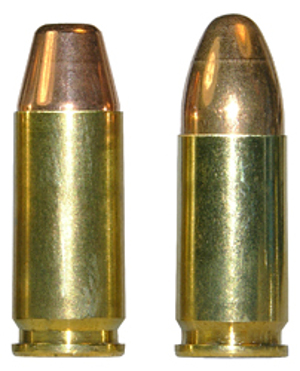
The 9×21mm pistol cartridge was designed by Jager, then adopted and commercialised by Israel Military Industries for those jurisdictions where military service cartridges, like the 9×19mm Parabellum, are or were illegal for civilian purchase.

The 7.92×57mm Mauser is a rimless bottlenecked rifle cartridge. The 7.92×57mm Mauser cartridge was adopted by the German Empire in 1903–1905, and was the German service cartridge in both World Wars. In its day, the 7.92×57mm Mauser cartridge was one of the world's most popular military cartridges. In the 21st century it is still a popular sport and hunting cartridge that is factory-produced in Europe and the United States.
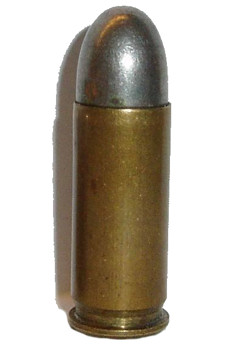
The .38 ACP, also known as the .38 Auto or 9x23mmSR, is a semi-rimmed pistol cartridge that was introduced at the turn of the 20th century for the John Browning-designed Colt M1900. It was first used in Colt's Model 1897 prototype, which he did not produce. The metric designation for the round is 9×23mm SR (semi-rimmed), which is not to be confused with other 9×23mm cartridges.

The .41 Action Express is a pistol cartridge developed in 1986 to reproduce the performance of the .41 Magnum police load in semi-automatic pistols.

The 7.65×53mm Mauser is a first-generation smokeless powder rimless bottlenecked rifle cartridge developed for use in the Mauser Model 1889 rifle by Paul Mauser of the Mauser company. It is also known as 7.65×53mm Argentine, 7.65×53mm Argentine rimless, 7.65mm Argentine, 7.65×53mm Belgian Mauser, 7.65mm Belgian, and 7.65×53mm Mauser.

The 9×23mm Winchester is a pistol cartridge developed as a joint venture by Winchester Ammunition and Colt's Manufacturing Company. The 9×23mm Winchester has a convoluted development history, but was commercially introduced by Winchester in 1996. Marketed primarily to competition shooters as a replacement for .38 Super for International Practical Shooting Confederation, United States Practical Shooting Association and International Defensive Pistol Association competition, the cartridge failed to find significant market success despite a high-profile introduction.

The 7.92×33mm Kurz is a rimless bottlenecked intermediate rifle cartridge developed in Nazi Germany prior to and during World War II, specifically intended for development of the Sturmgewehr 44. The ammunition is also referred to as 7.9mm Kurz, 7.9 Kurz, 7.9mmK, or 8×33 Polte. The round was developed as a compromise between the longer 7.92×57mm full-power rifle cartridge and the 9×19mm Parabellum pistol cartridge, and is the first mass-used intermediate cartridge in the world.

The FN 5.7×28mm is a small-caliber, high-velocity, smokeless-powder, rebated, bottleneck, centerfire cartridge designed for pistols and personal defense weapons (PDW) uses, manufactured by FN Herstal. It is similar in length to the .22 WMR and .22 Hornet. Unlike many new cartridges, it has no parent case; the complete package was developed from scratch by FN.
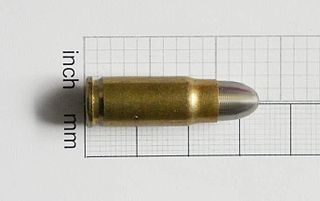
The 7.63×25mm Mauser round was the original cartridge for the Mauser C96 service pistol. This cartridge headspaces on the shoulder of the case. It later served as the basis for the 7.62mm Tokarev cartridge commonly used in Soviet and Eastern Bloc weapons.
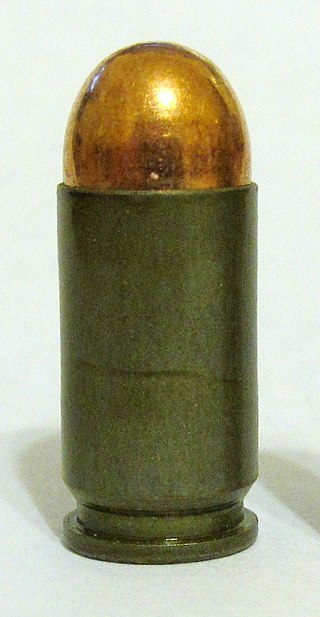
The 9×18mm Makarov is a Soviet pistol and submachine gun cartridge. During the latter half of the 20th century, it was a standard military pistol cartridge of the Soviet Union and the Eastern Bloc, analogous to the 9×19mm Parabellum in NATO and Western Bloc military use.

The 7.65×21mm Parabellum is a pistol cartridge that was introduced in 1898 by German arms manufacturer Deutsche Waffen- und Munitionsfabriken (DWM) for their new Pistol Parabellum. The primary developers of the pistol cartridge were firearms designers Georg Luger and Hugo Borchardt, who developed the round from the earlier 7.65×25mm Borchardt while working at DWM.
9mm Major, also known as 9 Major, ammunition is loaded much hotter than typical 9mm rounds, exceeding 1,550 ft/s (470 m/s) to achieve a power factor of 165. This classification benefits competition shooters as it allows maximum magazine capacity and scoring. However, it is not readily available and dangerous to use in pistols not designed for such high pressure. Most handgun manufacturers caution against using "+P" and "+P+" ammo, and 9mm Major loads generate even higher chamber pressures. The Taran Tactical "Combat Master" 2011 and similar pistols are designed for these pressures. In tactical situations, the added velocity may improve vest penetration, but it may hinder hollow-point projectiles' effectiveness due to over-expansion. Proper cartridge design is crucial for optimal performance.



















